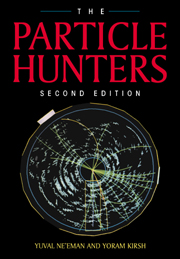Book contents
- Frontmatter
- Contents
- Preface to the first edition
- Preface to the second edition
- 1 The building blocks of the atom
- 2 Physical laws for small particles
- 3 The discoveries of the 1930s and 1940s
- 4 Particle accelerators — or from hunters to farmers
- 5 Strange particles
- 6 Basic forces and the classification of particles
- 7 Conservation laws
- 8 Short-lived particles
- 9 To the quarks — via the eightfold way
- 10 More quarks — or charm, truth and beauty
- 11 The Standard Model and beyond
- Appendix 1 Properties of semi-stable particles
- Appendix 2 The Greek alphabet
- Name index
- Subject index
6 - Basic forces and the classification of particles
Published online by Cambridge University Press: 05 August 2012
- Frontmatter
- Contents
- Preface to the first edition
- Preface to the second edition
- 1 The building blocks of the atom
- 2 Physical laws for small particles
- 3 The discoveries of the 1930s and 1940s
- 4 Particle accelerators — or from hunters to farmers
- 5 Strange particles
- 6 Basic forces and the classification of particles
- 7 Conservation laws
- 8 Short-lived particles
- 9 To the quarks — via the eightfold way
- 10 More quarks — or charm, truth and beauty
- 11 The Standard Model and beyond
- Appendix 1 Properties of semi-stable particles
- Appendix 2 The Greek alphabet
- Name index
- Subject index
Summary
Biologists who study the animal or vegetable kingdoms made use of a classification system which breaks down the hundreds of thousands of species into various groups, classes and families, according to generally accepted criteria. Were it not for the elucidation of this classification system, by Carl von Linné (Linnaeus) in the eighteenth century, Darwin would not have been able to conceive of the theory of evolution and biologists would have encountered great difficulties in doing research and in communicating their findings to their colleagues. While the number of various particles we have encountered so far is by no means as overwhelming as the number of living species, the overall picture at this stage may seem a little confusing to the reader who is making his first acquaintance with the world of elementary particles. Undoubtedly, the physicists who began discovering particle after particle felt the same way. A system of classification was thus essential in particle physics, as well. When we sort the particles into various categories, not only does the general picture become clearer, but the physical laws which reign over the jungle of particles also become increasingly apparent. In previous chapters we occasionally hinted that one group of particles or another constitute a single family.
- Type
- Chapter
- Information
- The Particle Hunters , pp. 117 - 132Publisher: Cambridge University PressPrint publication year: 1996



